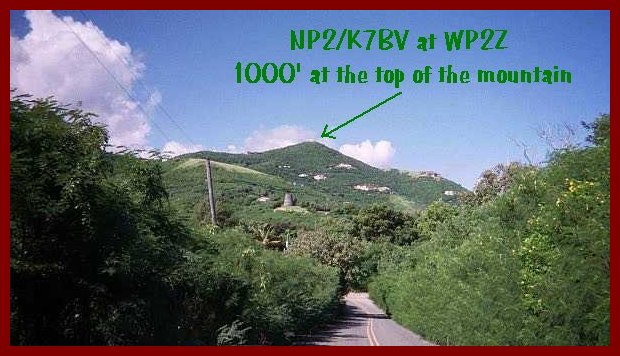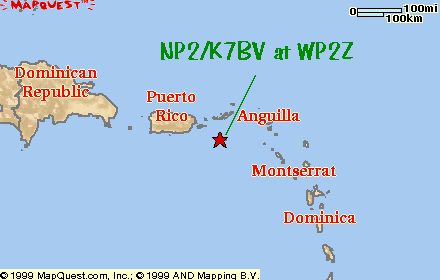


U.S. Virgin Islands
NP2/K7BV
Return to K7BV DX-Ventures


 Dennis Motschenbacher K7BV was the year 2000 trustee for the well-known DXpedition and Contest vacation QTH WP2Z. That call is a club call used by operators staying at the Windwood house high atop a mountain peak overlooking all of St. Croix.
Dennis Motschenbacher K7BV was the year 2000 trustee for the well-known DXpedition and Contest vacation QTH WP2Z. That call is a club call used by operators staying at the Windwood house high atop a mountain peak overlooking all of St. Croix.
For information about staying at the WP2Z, visit the WP2Z website

 TRIP PHOTOS
TRIP PHOTOS
- Windwood House - Front view of the house with the main tower in the background supporting a tribander.
- Pool - A hillside pool is located on the east side of the home, offering a terrific view of the island.
- Europe View - View to the northeast towards Europe. R7000 vertical in the foreground. 1000 foot radical drop off to the shoreline below is clearly seen in this brethtaking view from the house.
- West View - View to the west - northtwest towards W6. The 40 meter beam on a 30 foot tower is located about 200 feet from the shack. With the drop off to the shoreline 1000 feet below only a few yards away, the antenna performs like it is several hundred feet in the air.
- 40 Meter Beam - The 40 meter beam on a 30 foot tower is located about 200 feet from the shack. With the drop off to the shoreline 1000 feet below only a few yards away, the antenna performs like it is several hundred feet in the air.
- Columbus Landing - The cove on the left side of this view to the east from the house is believed to be where Columbus landed.
- Living Room - The living room is nicely appointed and has awesome views to enjoy while one relaxes in these bright surroundings.
- Dining Area - Located in the corner of the Dining Area, the operating position has a wonderful of the eastern half of the island.
- Operating Position - Close up of the operating position with the view through the adjoining windows.

The History of St. Croix Island
- Pre-Columbus
Prior to, and less than a century after Columbus' discovery, St. Croix was inhabited by two tribes of Indians: the Caribs and the Arawaks. The  Arawaks were generally considered to be a peaceful tribe while the Caribs were warring cannibals. The word "cannibal" is in tribute to their fierce nature for it is derived from the Spanish word for Carib or "carribales." Washington Irving described the Caribs:
"The hair of these savages was long and coarse, their eyes were encircled with paint, so as to give them hideous expression. Bands of cotton were bound firmly above and below the muscular parts of the arms and legs, so as to cause them to swell to a disproportionate size."
With such fearsome neighbors, the Arawaks were often forced to live on larger islands where they could retreat into the hills when attacked.
Arawaks were generally considered to be a peaceful tribe while the Caribs were warring cannibals. The word "cannibal" is in tribute to their fierce nature for it is derived from the Spanish word for Carib or "carribales." Washington Irving described the Caribs:
"The hair of these savages was long and coarse, their eyes were encircled with paint, so as to give them hideous expression. Bands of cotton were bound firmly above and below the muscular parts of the arms and legs, so as to cause them to swell to a disproportionate size."
With such fearsome neighbors, the Arawaks were often forced to live on larger islands where they could retreat into the hills when attacked.
- Spanish
On November 14, 1493, Columbus made his first visit to "Ayay" (as the Indians called St. Croix) and renamed it Santa Cruz. His reception by the Caribs gives testament to their violent character. Upon anchoring at Salt River, a small boatload of Spaniards approached the shore and encountered a small canoe carrying four men and two women. A battle ensued, which resulted from the Spaniards attempting to capture the natives. One Carib and one Spaniard were killed. The remaining Caribs were taken prisoner. This was the early beginning of what would soon be widely employed; slavery. In response to such conflict, Charles V of Spain declared that all Indians in the islands were enemies and should be eliminated.
A constant state of war existed between the Caribs and the Spaniards for nearly a century. By 1596, the islands were described as being wholly uninhabited. St. Croix was not a major port for the Spanish -- San Juan, Puerto Rico was far more important. Due to Indian attacks, bad weather, and general poor luck, the Virgin Islands were unfortunately described as "the useless islands."
- Dutch and English
The Dutch and English are grouped together for they settled the Virgin Islands almost simultaneously -- sometime in the early 1600's. Each country settled a separate side of the island: the Dutch settled the east end and the English the west. Inevitably, conflict erupted, but the manner in which it did is interesting. According to the English: the English Governor Brainsby was murdered by the Dutch Governor Capoen, while visiting Capoen in his house. A newly appointed Dutch Governor tried to arbitrate with the English and was granted protection to travel to their side of the island. Immediately upon arrival, he was seized and shot. After numerous battles, the Dutch ended up abandoning the islands. The English controlled St. Croix until 1650. In that year the Spanish sent a fleet of 5 ships and 1,200 men to St. Croix from Puerto Rico and slaughtered everyone! After only 15 years of domination, the English were ousted. The Dutch made one foolhardy attempt to recapture St. Croix. Assuming it to be abandoned, they sent two ships from St. Eustatius island. The two vessels dropped anchor right in front of Fort Frederik and proceeded to land. Unknown to the Dutch, the Spanish had left 60 men to guard the fort. The moment the landing boats reached shore, Spanish muskets killed all but ten men.
- French
Later the same year, the French sent two vessels to capture St. Croix and succeeded. The Spanish rule of St. Croix was over almost as soon as it had begun. The French fared poorly during their first colonization attempt in 1651. Of 300 colonists, two thirds and two governors died of illness during the first year. Burning the local forest during the dry season was a common practice, supposedly to destroy what they suspected was the home of disease.
- Knights of Malta
Ten years later the Governor of St. Kitts, De Poincy, bought St. Croix as his private estate and later deeded it to the Knights of Malta. The Knight of Malta were not true knights in the medieval sense but were a religious group also known as the Order of St. John of Jerusalem. The Order fared poorly and in general were considered to be rich young aristocrats who knew little about colonization. In 1665, the French West Indian company bought the island from the Knights. At last, St. Croix had proper management under its new Governor DuBois and flourished. In short time the island had 90 plantations. Crops included tobacco, cotton, sugar cane and indigo. After DuBois´ death, bad administration, drought and sickness ended what advances had been made. From 1695 to 1733, St. Croix was considered abandoned.
- Denmark
In 1733, the French Government sold St. Croix to the Danish West India & Guinea Co. for approximately $150,000. Shortly after this transaction, the Danes made a clever move by allowing immigrants of other nationalities to move in. The result was rapid development as everyone from the Spanish Sephardic Jews to the Huguenots purchased the available plantations. The English soon dominated the populations and English became the language spoken on the streets. It was under Danish rule that the sugar plantations flourished. On St. Croix, for over two centuries, sugar was king! To this day, the sugar plantations scattered around the island are visible. Sugar was destined to success -- the markets in Europe were huge, and sugar cane could only be grown in tropical zones.
- United States of America
Denmark sold the Virgin Islands to the United States of America in 1917 for $25 million. St. Croix is now a U.S. Territory, along with the other U.S. Virgin Islands, St. Thomas and St. John. The island´s residents are U.S. citizens.
History compiled by Frans Lawaetz.

License
No special arrangements are required for USA citizens to operate KP2/home call. Overseas operators can take advantage of the new CEPT participation by the USA.

Antennas
The station comes complete with the option to use two tribanders, a 2 el 40 meter beam, a R7000 vertical and numerous wire antennas.

QSL Information
- Steve KU9C has unselfishly volunteered to serve as the QSL Manager for all NP2/K7BV & WP2Z QSOs. A self addressed, return envelope with postage costs covered is requested.
- Steve Wheatley KU9C
- P O BOX 5953
- Parsippany, NJ 07054


Thanks for being visitor number  !
!
Web site design assistance and hosting provided by KA9FOX at QTH.COM






 Dennis Motschenbacher K7BV was the year 2000 trustee for the well-known DXpedition and Contest vacation QTH WP2Z. That call is a club call used by operators staying at the Windwood house high atop a mountain peak overlooking all of St. Croix.
Dennis Motschenbacher K7BV was the year 2000 trustee for the well-known DXpedition and Contest vacation QTH WP2Z. That call is a club call used by operators staying at the Windwood house high atop a mountain peak overlooking all of St. Croix.



 Arawaks were generally considered to be a peaceful tribe while the Caribs were warring cannibals. The word "cannibal" is in tribute to their fierce nature for it is derived from the Spanish word for Carib or "carribales." Washington Irving described the Caribs:
"The hair of these savages was long and coarse, their eyes were encircled with paint, so as to give them hideous expression. Bands of cotton were bound firmly above and below the muscular parts of the arms and legs, so as to cause them to swell to a disproportionate size."
With such fearsome neighbors, the Arawaks were often forced to live on larger islands where they could retreat into the hills when attacked.
Arawaks were generally considered to be a peaceful tribe while the Caribs were warring cannibals. The word "cannibal" is in tribute to their fierce nature for it is derived from the Spanish word for Carib or "carribales." Washington Irving described the Caribs:
"The hair of these savages was long and coarse, their eyes were encircled with paint, so as to give them hideous expression. Bands of cotton were bound firmly above and below the muscular parts of the arms and legs, so as to cause them to swell to a disproportionate size."
With such fearsome neighbors, the Arawaks were often forced to live on larger islands where they could retreat into the hills when attacked.




!